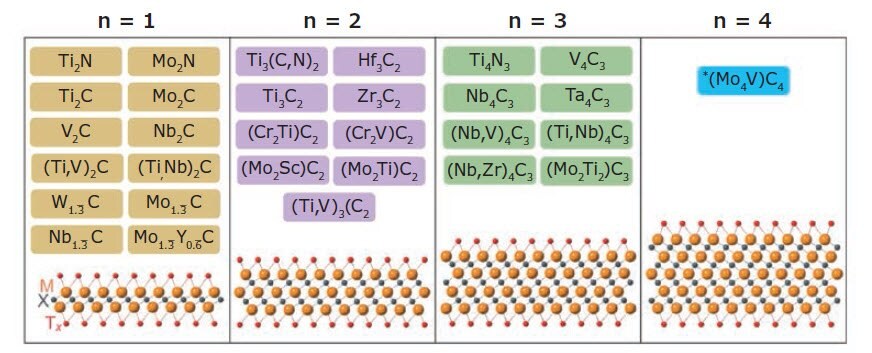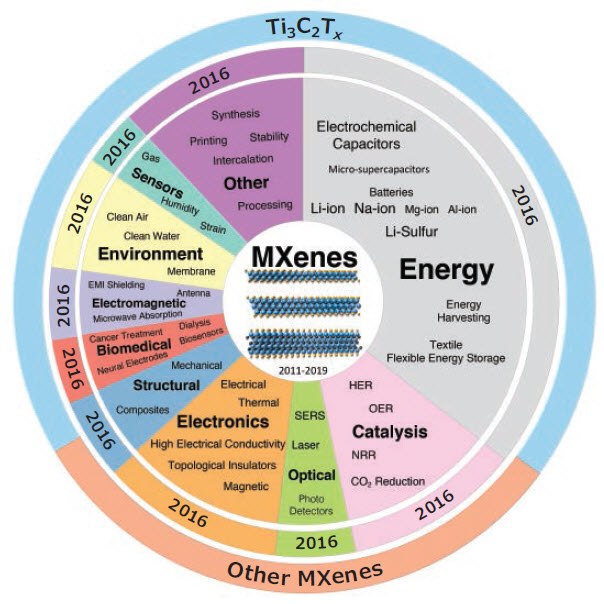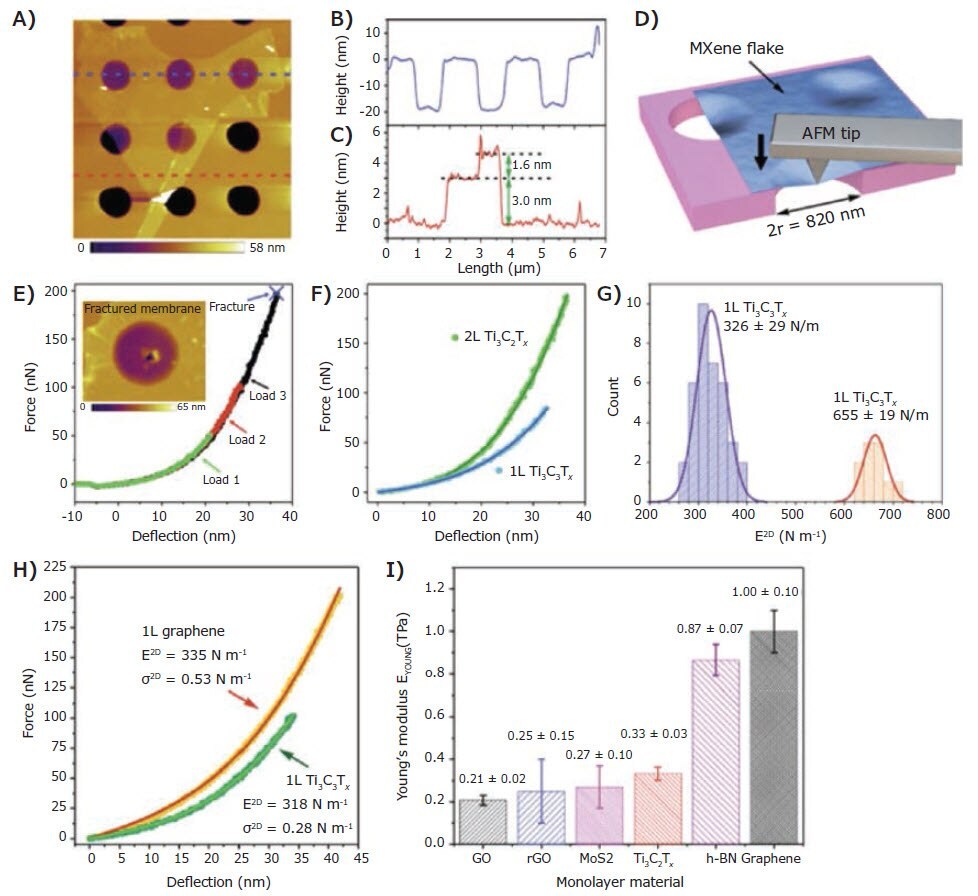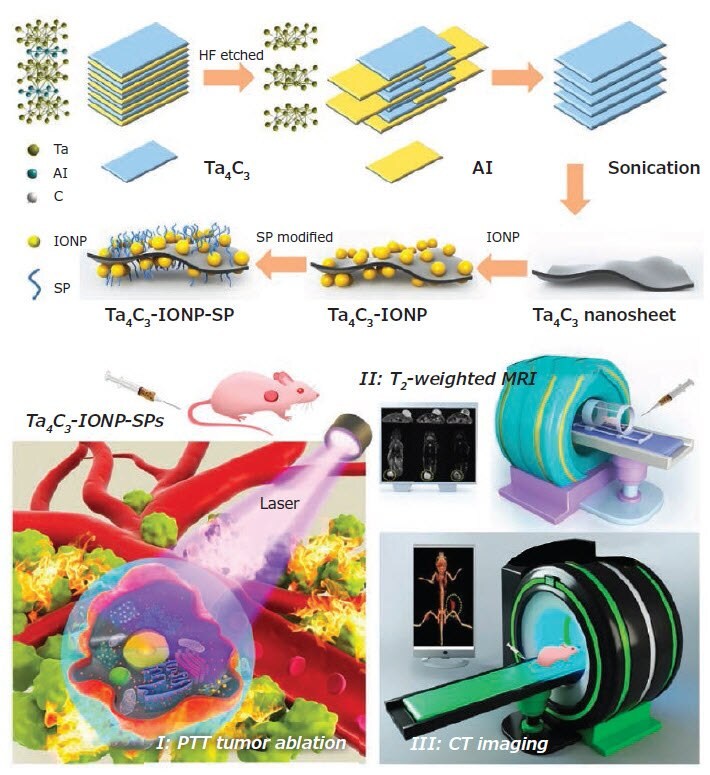MXenes: A Tunable Family of 2D Carbides and Nitrides
Christopher E. Shuck and Yury Gogotsi
A. J. Drexel Nanomaterials Institute and Department of Materials Science and Engineering, Drexel University, Philadelphia, PA 19104, USA
Introduction
Two-dimensional (2D) materials have been the focus of significant research due to their unique electronic, optical, and mechanical properties. Since the discovery of the unusual physical properties of graphene in 2004, research groups around the world have focused on the discovery, development, and applications of 2D materials. Following the development of graphene, a wide variety of other 2D families have been explored, including recently discovered single elemental structures (phosphorene (902896), stanene, silicene, germanene (906026), etc.), and known binary compounds (BN (901349, 901410), transition metal dichalcogenides (TMDs) (901867, 901187, 902462, 903841), oxides, etc.), or more complex compositions, such as clays. In 2011, a family of conductive 2D carbides, nitrides, and carbonitrides, known as MXenes, was discovered.1
MXenes are potentially the largest class of 2D materials known today, with more than 30 different types reported (Figure 1), and hundreds computationally studied in-silico. Moreover, there exists the potential for thousands of additional members of this family if solid solutions are included.2 MXenes have the general structure Mn+1XnTx, where M is an early transition element (Ti, V, Nb, etc.) and X is C and/or N, with n ranging from 1–4.3 Tx represents the surface terminations (typically -O, -OH, and -F), with n+1 layers of M covering n layers of X in the arrangement of [MX]nM. These conductive, hydrophilic 2D ceramics are synthesized via top-down selective etching of their precursor materials MAX phases (910740, 910767, 910775, 910759, 910821, 910708), typically in the form of Mn+1AXn, but some MXenes are synthesized from different precursors, including M2A2X and Mn+1AxXn+x as well. The synthesis of MXenes has been shown to be readily scalable, with no change in the properties as the batch size is increased.4 In these cases, A is primarily Al, but Si and Ga have also been used.2 MXenes come in multiple forms: single metal element structures (Ti3C2Tx, Ti2CTx, V2CTx, etc.), ordered double transition metal MXenes (i.e., Mo2Ti2C3Tx, Mo2TiC2Tx, Cr2TiC2Tx, etc.), solidsolution MXenes (i.e., Ti2-yVyCTx, Mo4-yVyC3Tx, Ti2-yNbyCTx), and ordered divacancy MXenes (Mo1.33CTx, W1.33CTx, etc).2 The MXene family is quite diverse, with the materials that can be tuned through a variety of approaches, including modification of the number of atomic layers (n), changing the M or X elements, adjusting the surface chemistry (Tx) through post-treatment or during synthesis, size selection of MXenes, and intercalation of different species into the structure, among multiple other approaches.2

Figure 1.MXene compositions reported to date. MXenes have the general structure Mn+1XnTx where M is an early transition metal (Ti, V, Nb, etc.), X is C and/or N, Tx are the surface terminations (typically -O, -OH, -Cl and -F), and n = 1–4. MXenes discovered to date include mono-M MXenes, ordered double-transition metal MXenes, solid-solution MXenes, and ordered divacancy MXenes.3
MXenes typically come in two forms, multilayer (ML) powder or delaminated single flakes. To synthesize ML MXene powder, typically fluoride-containing etchants (HF or HF/HCl) are used to selectively remove the A (in most cases Al) layer. To convert the ML powder into a single-flake colloidal solution, an intercalant (i.e., LiCl, tetramethylammonium hydroxide (TMAOH), dimethyl sulfoxide (DMSO), etc.) is used.5 Another approach where the precursor is simultaneously etched and delaminated using an in-situ HF formation approach (HCl+LiF, NH4HF2 (455830), etc.) can be used.5 Because MXenes are primarily synthesized via a topochemical process in an aqueous environment, they maintain a hydrophilic nature. Due to this hydrophilicity, MXenes can be processed using standard solution-based techniques (primarily water-based), including vacuum filtration, spray-coating, dip-coating, spin-coating, etc. In addition to aqueous solvents, MXenes form stable colloidal solutions in polar organic solvents, including dimethylformamide (DMF), N-methyl-2-pyrrolidone (NMP), propylene carbonate (PC), and ethanol.6 Due to their extensive customizability (e.g., composition, surface terminations, thickness, etc.) and processability, MXenes have already found use in multiple diverse fields, including energy storage devices, biomedical applications, composite materials, electrochromic devices, and countless other applications (Figure 2).

Figure 2.Applications and properties of MXenes explored to date. The center pie chart shows the ratio of publications in each application/ property of MXenes with respect to the total number of publications on the “MXene” topic from 2011 to February 2019 based on Web of Science. The middle pie chart ring, with similar color to the center one, shows the starting year for exploration of each application/property of MXenes. There might be one or two papers published before some of the mentioned years; we considered a year with a few important publications as the starting year for each slice. The outer ring shows the ratio of publications only on Ti3C2Tx MXene versus the publications on all MXene compositions (M2XTx, M3X2Tx, M4X3Tx), and M5X4Tx).2,7
Applications of MXenes
The first application of MXenes was as energy storage materials. Ti3C2Tx, for example, was shown to have a volumetric capacitance of up to 1,500 F cm-3.8 Considering this property, it is expected that thinner (M2XTx) MXenes can have a higher theoretical gravimetric capacity. Significant work has focused on utilization of various MXenes as energy storage materials.9 Within energy storage devices, MXenes have been used as electrodes in electrochemical capacitors, micro-supercapacitors, and batteries, utilizing Li-, Na-, Mg-, Al-, and other chemistries, with a wide variety of electrolytes being used, including aqueous (e.g, H2SO4, Li2SO4, KOH, etc.) and non-aqueous organic (e.g., DMSO, PC, acetonitrile (ACN), etc.)-based solutions (Figure 3), in addition to ionic liquids.2, 9-11 Depending on the electrolyte system used, the usable voltage range can extend from 0.5 to 3.0 V.2 Due to the large number of inherent chemistries available to MXenes, significant work has been done to examine the charge storage mechanisms of various MXenes, as well as how to further optimize the materials. MXenes typically have a pseudocapacitive storage mechanism; the ions penetrate between MXene sheets, interacting with the surface terminations on the basal plane. Depending on the ions used, the MXene interlayer spacing can be varied, accommodating the size of the intercalating ion.12 Finally, MXenes have excellent cyclability, with no change in the capacitance recorded after 10,000 cycles for Ti3C2Tx in aqueous electrolytes.11 The use of metallically-conductive MXenes as binders and current collectors in energy storage devices is also very promising. While a significant portion of MXene research has focused on energy storage capabilities, a wide variety of other applications have also been explored.

Figure 3.Macroporous Ti3C2Tx electrode with 1 M LiTFSI in DMSO, ACN and PC organic electrolytes. A), CV curves. The OCVs (marked by arrows) are −0.13 V (black), −0.32 V (blue) and −0.12 V (red) versus AgCI for DMSO, ACN and PC-based electrolytes, respectively. B), Chronoamperometry data collected at the applied maximum potentials. C), EIS data collected at the OCV. D), EIS data collected at the maximum negative potential versus AgCI. The insets in C and D show the magnified curves in the high-frequency range; they use the same units as in C and D. E), Schematic of a supercapacitor using 2D MXene (pink, Ti; cyan, C; red, O) as negative electrode with solvated or desolvated states. Legend for the electrolyte: green, cation; orange, anion; yellow, solvent molecule.10
MXenes have unique optical properties and applications, such as electrochromic devices, transparent conductors, electron transport layers, etc. Both, the thickness (n) and chemistry affect the optical absorption spectra, meaning a different MXene can be used based on specific optical needs. For example, Ti3CNTx was shown to exhibit thickness-dependent nonlinear saturable absorption at high light fluences, making it useful for mode-locking in fiber-based femtosecond lasers.13 Furthermore, a photodiode based on Ti3C2Tx was shown to break time-reversal symmetry, achieving nonreciprocal transmission of nanosecond laser pulses.13 Recently, it was shown that MXenes are tunable electrochromic materials; depending on the bias used, the optical absorption peak of Ti3C2Tx can be reversibly and controllably shifted by more than 100 nm.14 Additionally, MXenes have been used for surface-enhanced Raman spectroscopy, with calculated enhancement factors reaching 106, leading to the possibility of enhanced biochemical molecular sensing.15 Due to the plasmonic nature of MXene optical properties, it is likely that they will soon find diverse optical applications spanning a wide wavelength range.
Recently, significant attention has been focused on the electronic and electromagnetic properties of MXenes due to their high electrical conductivity and processability. For example, Ti3C2Tx was recently shown to have the highest electromagnetic interference shielding effectiveness of all synthetic materials with comparable thickness, a 45 μm film corresponds to 92 decibels (dB), a 2.5 μm film gives >50 dB, and a 50 nm film gives 20 dB.16 It was also shown that MXenes can be used as spray-on flexible antennas and radiofrequency identification (RFID) tags with only ~100 nm film thickness required.17 Some double-M MXenes (Mo, W, Ti, Zr, and Hf-based) have been proposed as topological insulators owing to the ability to use light and heavy elements simultaneously to tune the structure.18 Furthermore, a number of MXenes (Cr-, Mn-, V-, and Ti-based) are expected to exhibit ferromagnetic or antiferromagnetic properties, depending on the specific chemistry and surface terminations.19 Due to the high conductivity and surface functionalization of MXenes, it is possible to use them as gas sensors with a very high signal-tonoise ratio, and very low detection limits. For example, the limit of detection for Ti3C2Tx was calculated to be 0.011 and 0.13 ppb for acetone and ammonia, respectively, which are some of the lowest values ever reported.2 It was found that these MXene based gas sensors outperformed other 2D materials in terms of signal-to-noise ratios.2
The elastic properties of Ti3C2Tx were studied and the Young’s modulus of a single Ti3C2Tx layer was found to be 0.33 TPa, which is the highest of any solution-processed 2D material (Figure 4).20 Due to these extreme mechanical properties and coupled with their desirable optical/electronic properties, MXenes have been widely utilized in composites. Recently, ceramic and metal matrix composites have been reported. In addition, because MXenes are water processable, polymeric composites are fabricated in polar solvents; research groups have used a variety of polymers, including polyvinyl alcohol (PVA) (363065, 563900, 341584), polyacrylamide (PAM) (92560 and 749222), polyethyleneimine (PEI) (904759, 181978), polyethylene glycol (PEG) (MM Cat. No. 8.18892), and other polymer systems.21 These composites have been used for a variety of applications, including electromagnetic interference shielding, electrocatalysts, electrochemical energy storage systems, and many others. In addition to polymeric composites, heterostructures have been synthesized in conjunction with other 2D and 1D materials, including graphene (900561, 763705, 777676), carbon nanotubes (901046, 901082, 901056), transition metal oxides (TMOs), transition metal dichalcogenides (TMDs), and others.22 In addition to composites fabricated with polymers or other 2D materials, MXenes have also been utilized in smart fabrics. The hydrophilicity of MXenes allows them to easily coat natural fibers, such as cotton and wool, synthetics, such as polyester, and to be combined with other materials for spinning into fibers.2 These composites have been used as knitted flexible supercapacitors for energy storage, as conductive fibers, and as wearable smart textiles.2 Thus, by combining MXenes with other materials to form composites, the advantages of both materials can be realized. The large variety within the MXene family, coupled with the diverse families of materials with which they can be composited, leads to a massive library of possible composite systems with the ability to choose specific properties of interest.

Figure 4.Mechanical measurements of monolayer and bilayer Ti3C2Tx flakes. A) Noncontact AFM image of a monolayer Ti3C2Tx flake placed over an array of microwells in a Si/SiO2 substrate. B,C) Height profiles along the B) dashed blue and C) red lines shown in A). D) Scheme of nanoindentation of a suspended Ti3C2Tx membrane with an AFM tip. E) Force–deflection curves of a bilayer (2L) Ti3C2Tx flake at different loads. The inset shows an AFM image of the fractured membrane. F) Comparison of loading curves for monolayer (1L) and bilayer (2L) Ti3C2Tx membranes. Hole diameter is 820 nm. G) Histogram of elastic stiffness for 1L and 2L membranes. Solid lines represent Gaussian fits to the data. H) Comparison of experimental force–deflection curves for monolayer graphene and Ti3C2Tx membranes. I) Comparison of effective Young’s moduli for several 2D materials: GO, rGO, MoS2, h-BN, and graphene. The chart compares values produced on membranes of monolayer 2D materials in similar nanoindentation experiments.20
Many research groups have begun investigating the environmental applications of MXenes, including gas separation and water purification. Due to the stacked layer morphology of MXene films, it is possible to achieve >2200 Barrer H2 permeability with a H2/CO2 selectivity >160.23 It was also shown that cations (K+, Na+, Li+, Ni2+, Ca2+, Mg2+, and Al3+) can be selectively filtered from water with high permeability by varying the interlayer spacing of MXene films.24 Mo1.33CTx was studied for brackish and seawater desalination, showing that ion removal in seawater concentrations (600 mM NaCl) could be achieved with low energy consumption (17 kT), which is in absence of any ion exchange membranes.25 It was also shown that Ti3C2Tx is viable for the removal of various heavy metal ions, including Cr, Pb, Cu, and others at relatively high rates.26 While research into this direction is relatively recent, MXenes have demonstrated potential to play a major role in future environmental efforts.
MXenes have found promise in biomedical applications, including biosensors, antibacterial materials, in bioimaging, as therapeutics, and in theranostics (Figure 5).27 The majority of biomedical applications have focused on Ti-, Nb-, and Ta-based MXenes due to their non-toxic nature. No cytotoxicity has been observed for Ti3C2Tx so far. A variety of biosensors have been fabricated, focusing on detection of small molecules, including NH3, H2O2, glucose, and even heavy metals. Ti3C2Tx has also been found to be viable for type-I photodynamic therapylike cell killing. MXenes can also inhibit bacterial growth by imposing oxidative stress on the bacterial cell membranes. Due to the optical properties inherent in MXenes (i.e., the specific absorption spectra depend on the MXene chemistry), they can be used for bioimaging (both for photoacoustic or luminescence imaging) or as contrasting agents for computed tomography. MXenes have also been used as therapeutics for reactive oxygen species generation, as photothermal materials, and for drug cargo loading for synergistic therapy (theranostics). Two other important medical applications of MXenes include sorbents for removal urea and other toxins form blood,28 as well as implantable and skin electrodes.29-30 While the applications of MXenes in the biomedical field are still relatively new, the breadth of research already conducted illustrates the variability and promise of this family for future work.

Figure 5.Schematic illustration of the fabrication process of Ta4C3-IONP-SPs composite nanosheets and their unique functionality for dual-modal contrast-enhanced MRI/CT imaging-guided photothermal ablation of breast cancer.31
Conclusions
The unique electronic, optical, chemical and mechanical properties of MXenes coupled with the ease of processing have helped to demonstrate their tremendous promise for revolutionizing many fields. While the initial focus of MXene research has been for energy storage, their area of potential applications has since broadened to include fields ranging from smart textiles to medicine, communication, gas sensors and electrochromic devices, and in environmental remediation. Considering the growing number of discovered MXenes available, further control over the surface chemistry, better fundamental understanding of properties, and advances in MXene processing, it is likely that numerous novel applications of MXenes will also be discovered.
Materials
References
To continue reading please sign in or create an account.
Don't Have An Account?